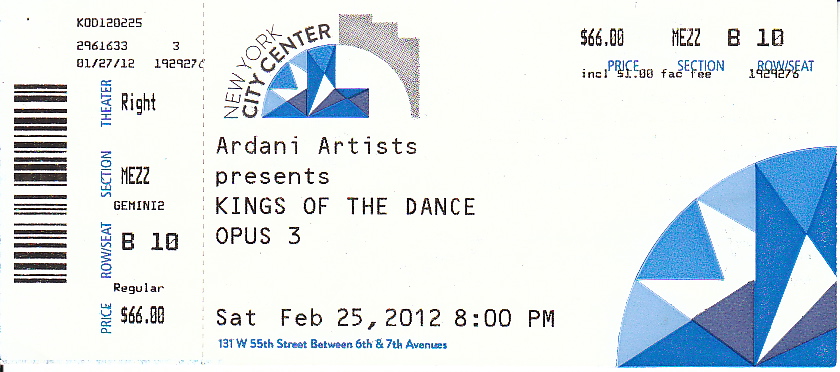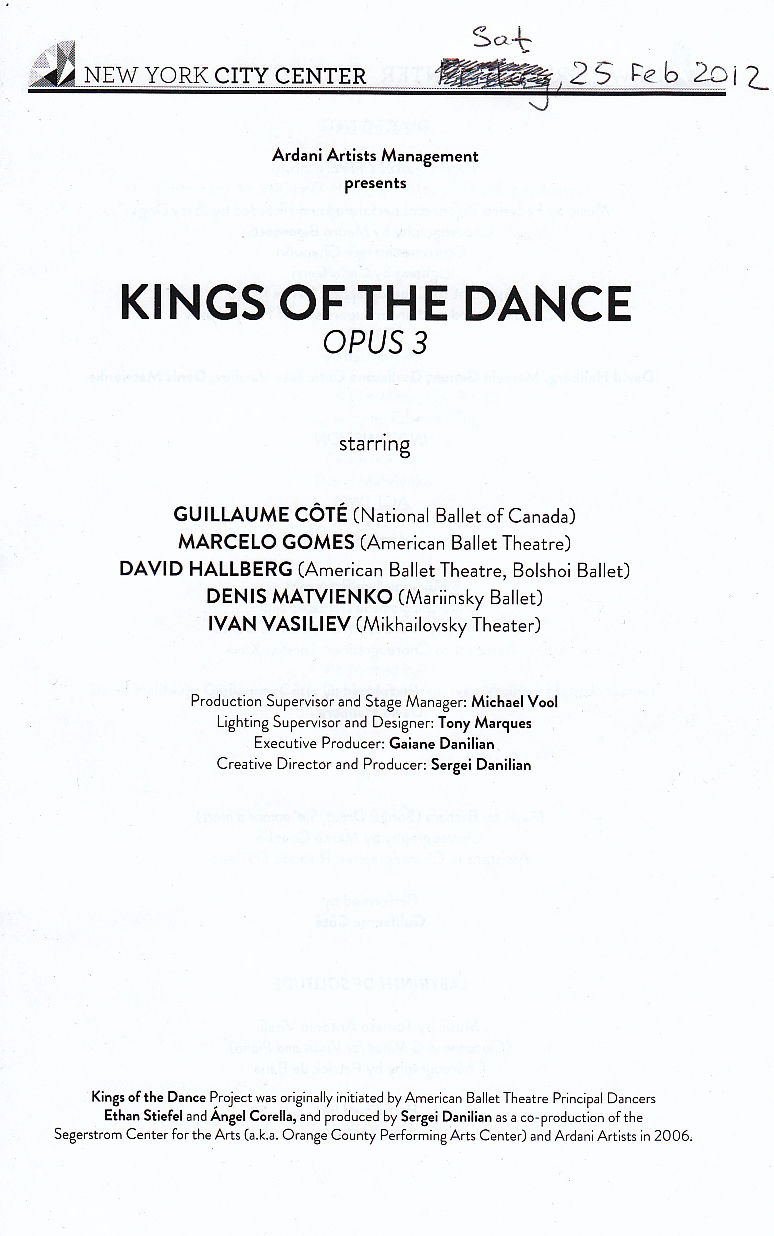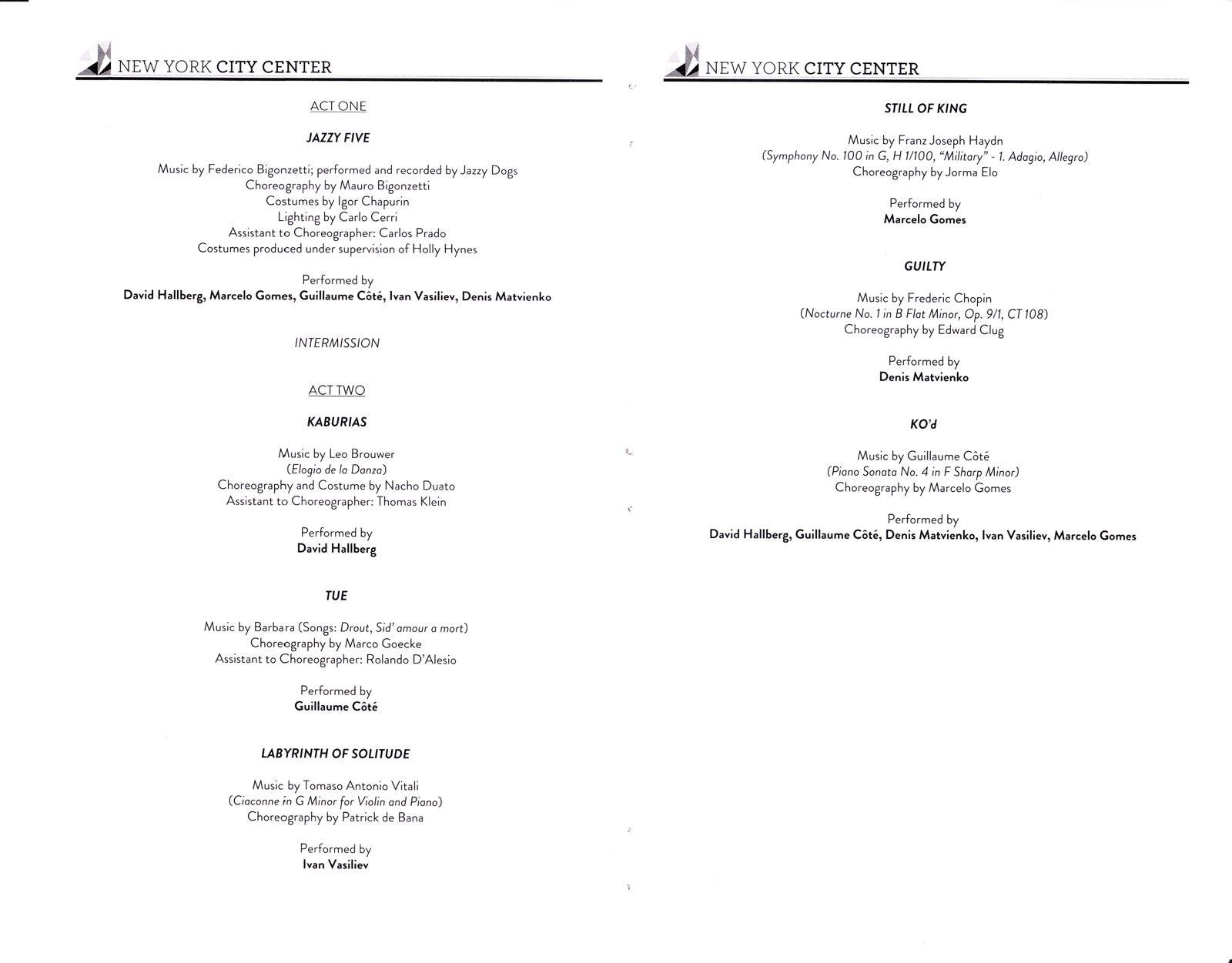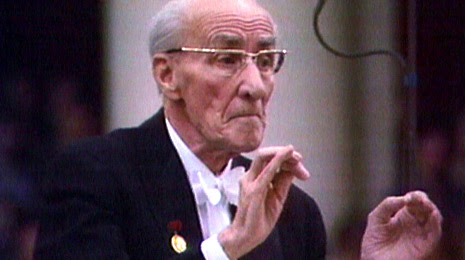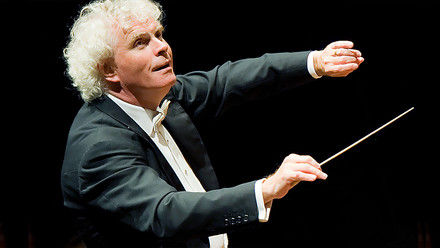
On February 24th, 2012, I attended a performance of the Bruckner's Symphony No. 9 for the second time in my life. It was in New York's Carnegie Hall, and I had the best seat in the house: first row at the first tier on the left. Simon Rattle conducted the Berliner Philharmoniker, and the concert marked the first time the Finale reconstructed from the sketches Bruckner left at the time of his death was heard in the U.S.
Jeremy Geffen and Simon Rattle introduce Bruckner's Symphony No. 9
I've never understood why some find Bruckner's Ninth boring. While quite long (about an hour, without the Finale), to me it always seemed fascinatingly magnetic: once you approach this large celestial body, it pulls you into its gravitational field: you orbit the massive planet and discover its vast valleys, chasms, and mountains opening before your eyes. Each interpretation is like a new orbit in that you see the same landscapes from a different perspective, and thus your exploration is never finished.
As
Walter Frisch noted in his pre-concert talk, Bruckner is a two-faced Janus: while his music is firmly rooted in the Viennese tradition of the past, it also anticipates the discoveries of the 20th century. Indeed, Bruckner's Ninth is in D minor, the same key as Beethoven's Ninth; and one cannot help noticing certain similarities between the two. Perhaps, even more striking is its debt to the Schubert's last symphony—“The Great”. Yet Bruckner's music—definitely influenced by Wagner (Bruckner even dedicated his Symphony No. 3 to him) and which, in turn, influenced Mahler—is as rich in its sonorities as Debussy's and Rimsky-Korsakov's, and its unprecedented dissonances and novel orchestration anticipate the innovations of Stravinsky, Schoenberg, and Shostakovich.

 Program notes
Program notes
As I sat in my comfortable chair in the box's front row listening to the fabled Karajan's orchestra, my memories rushed back to another concert that took place 32 years ago, on January 30th, 1980, at the Great Hall of the Leningrad Philharmonic.
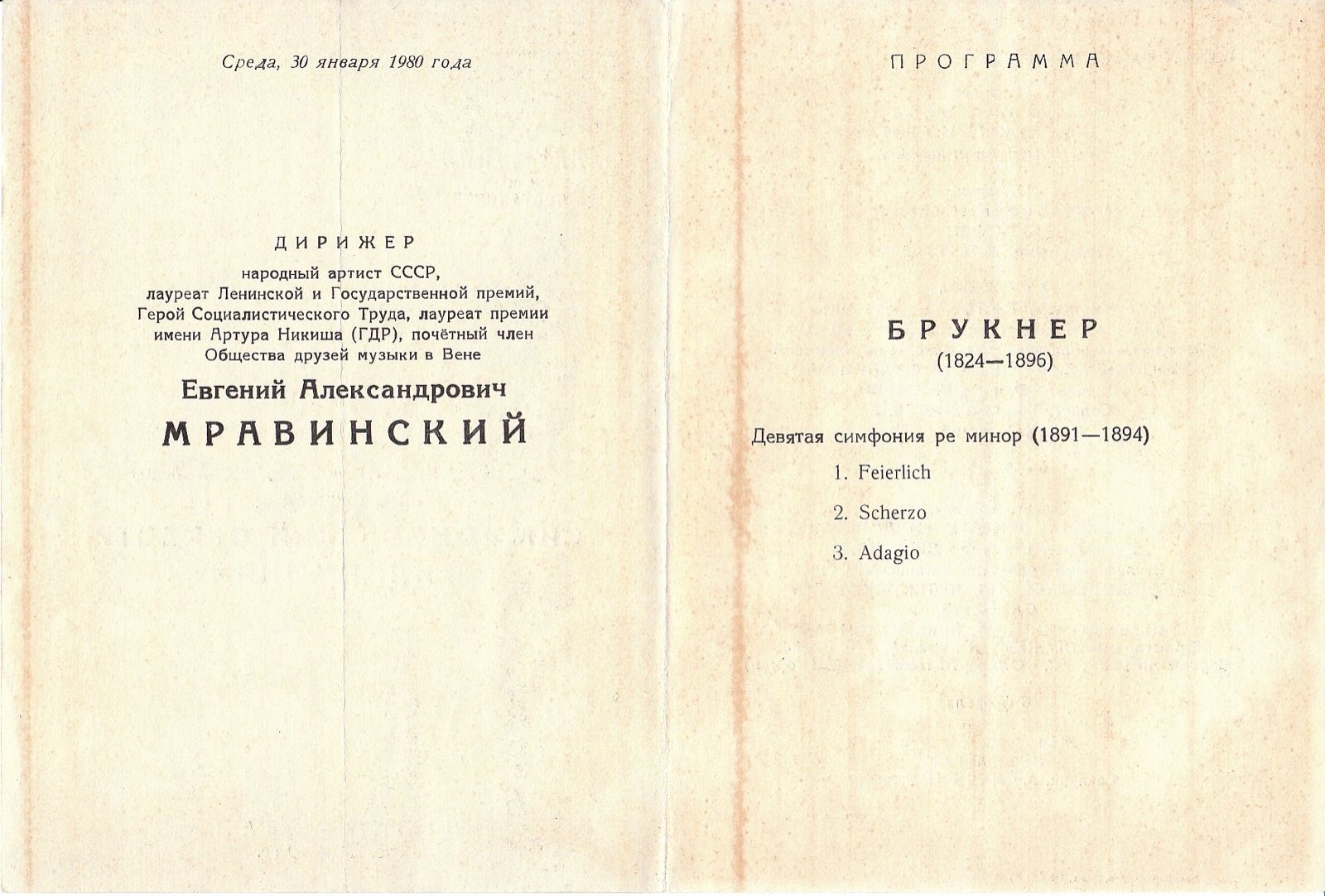 Program notes
Program notes
It was the first time I saw Yevgeny Mravinsky. I had heard a lot of him from my parents and my brother who had often attended his concerts, and I coaxed my brother into taking me to the performance. It was virtually impossible for people without connections to get seats; the concert was sold out, and we were lucky to get standing room tickets. Fortunately, we came early enough: the gathering crowd of concertgoers was so thick that it was difficult to find a good spot even in the standing room. We found a decent spot behind one of the loges on the left side of the Hall and stood there in anticipation.
One could feel the charged atmosphere: Bruckner's Ninth was performed extremely rarely: the last time Mravinsky played it was—remarkably—in 1945, right after the war. From my spot behind the loge I could see the glitterati, the stars of Leningrad beau-monde, sitting at the first couple of loges on the right: I recognized a famous
theater director, a
well-known actor, a
music director of the Kirov Opera and Ballet…
The huge orchestra filed to the stage and took its seats. A moment of silence ensued. Then,
with a squeak, the dark-red curtains on the left side of the stage pulled apart and out came Mravinsky. He cut the most extraordinary figure I had ever seen. Extremely tall and gaunt, he slowly walked through the orchestra paying no attention to the thunderous applause greeting him. He seemed to be surrounded by an aura of silent concentration. Having reached the podium, he sat down on a high stool, opened the score, lifted his hands in a gesture reminiscent of the saints in the icons of Theophanes the Greek, and the magic began.
I am not sure “magic” is the right word: I had a distinct feeling that I was witnessing something unique and absolutely extraordinary. It was as if the conductor was literally
a conductor—a conduit transmitting the higher truth he managed to attain. It felt like eavesdropping on a communion of a saint with God—with music of the spheres emanating from the 100-strong orchestra.
I did realize that I was witnessing a revelation: every note was worth remembering, and yet the stream of sound was rushing past me; precious music phrases were slipping away, being irretrievably lost forever. I felt that I had to capture, retain them in my memory; I made an effort to do so… and the next thing I remember was being supported by my brother and the muffled commotion of the standing room crowd around me. Apparently, I fainted somewhere in the beginning of the third movement (Adagio), and when I regained consciousness a moment later my brother helped me walk out of the concert hall. It turned out that the Philharmonic kept a medical doctor on duty during public performances. I was escorted to his office, and the doctor, having given me a glass of water with valerian drops, said ruefully, “I hoped, at least today I would be able to listen to the entire concert,” (he sighed) “but no such luck.”
Later I read in the review

that afterwards a
poet told Mravinsky: “Tonight you conducted not only an orchestra—you conducted our souls.”
One cannot help but notice certain parallels between Bruckner and Mravinsky. Indeed, after performing the Ninth in Vienna later the same year, Mravinsky—the honorary member of Musikverein—was reverentially referred to as “Herr Bruckner” by the Viennese press. “The spiritual core of and intellectual power of the Bruckner symphonies were central to Mravinsky's ethic as a musician: the power of religion and nature.” (
Tassie, G. (2005),
Yevgeny Mravinsky: The noble conductor, The Scarecrow Press, Lanham, Maryland, p. 243.)
Both men were deeply religious. Bruckner dedicated his Ninth's symphony “dem lieben Gott” (to the beloved God). Mravinsky believed that one ought to play music for God, and that the presence of the audience was incidental; people in the audience being witnesses to the sacred mystery.
Luckily, the January 30th, 1980, performance was
recorded (
first,
second, and
third movements). Let us compare the two performances: the audio clips below contain recordings of the same fragment: the end of the second movement (Scherzo).
Even though the music fragment is small, the comparison makes it clear that the two interpretations could not have been more different. Obviously, Mravinsky's tempo is noticeably faster. Yet, other differences are more significant: the bow-strokes of the stringed, as well as the phrases of the brass, under Mravinsky are very short, pointed, precise, and restrained, while under Rattle they are longer, more emphatic, and kind-of smudged. That results in a very different tonal quality: while Mravinsky's Bruckner lacks any sentimentality and sounds like a glimpse into the future, e.g., Stravinsky, Rattle's sound is much more Romantic, if not outright romanticized, and his interpretation firmly links the composer back to Beethoven and Schubert.
After listening to the whole symphony, one comes to the conclusion that perhaps the greatest strength of Mravinsky's performance is the perfect balance of its architectonics: that is, a certain inevitability of the progression from the first movement to the second to the third. One gets a sense of the logically unified concept, despite the symphony's considerable duration and the distinct character of each movement. Another striking feature is what Abram Yusfin referred to as the “discernability of music texture,” i.e., the distinct timbral quality of each instrumental group. Mravinsky used the Nowak edition but, according to
Tassie (p. 243), facilitated the timbre of brass and woodwind. Other qualities that make the score breathing and alive are the astonishing contrasts of volume, from
ppp to
fff; the pregnant pauses; and the variability (always warranted and never gratuitous) of tempos and rhythms throughout the entire piece.
Rattle's performance at the Carnegie Hall was very engaging: in no moment did I feel disconnected from the music. Interestingly enough, he conducted the entire symphony, including the new Finale, from memory, without a score. It seems that the first and second movement could use more dynamic variety, in terms of both volume and tempos, and that pauses could have been longer and more imbued with meaning. However, in the first movement, the ritardando combined with diminuendo was amazing, as was the culmination. In the second movement, the precision of the stringed's pizzicato was impeccable, and the unexpected accelerando after the pause, before the final return of the opening theme, was indeed refreshing (this can be heard in the clip above). The highlight of the entire performance though was the Adagio—Bruckner's own “farewell to life.” Rattle achieved an unparalleled cohesiveness of the entire third movement; the perfect balance of sound, tempo, rhythm, and pauses. Music flowed naturally, organically from one contrasting episode to another, inexorably leading through jarring dissonances to an immense culmination that then transfigured into harmonic serenity.
As to the Finale, it was a noble endeavor—and Simon Rattle made a convincing case for it. Indeed, we need to approach the “new” Ninth with an open mind and give the Finale the benefit of the doubt.
However, a work of art, once it parts with its creator, tends to acquire a life of its own; and to me, the Bruckner's Ninth seems no more in need of Finale than the Schubert's
Unfinished Symphony or Beethoven's piano sonata No. 32, Op. 111:
We had only needed to hear the piece to answer the question ourselves. A third movement? A new approach? A return after this parting—impossible!
(Thomas Mann, Doctor Faustus, chapter 8)
The Berliner Philharmoniker is one of the world's great orchestras, and the leaders of each instrumental group are formidable musicians. I can't forget the duet of the flutе and double-bass in the third movement or the astonishing vibrato of the cellos in the third. Thus it was indeed gratifying to see Simon Rattle walking over to each orchestral group and thanking them after the performance.
Coming back to comparing the two performances of the Bruckner's Ninth that I heard 32 years apart, again—they could not have been more different. Listening to Mravinsky was like witnessing a divine revelation, like being present at the unfolding of a grandiose mystery. The conductor, like a medium, made the music of celestial spheres audible for us to hear. Listening to Rattle, on the other hand, felt very much like an earthly, grounded experience. There was noting mysterious in his performance; it felt warm and very much human.
Here is the
trailer of Simon Rattle conducting the Berliner Philharmoniker (small excerpts from the Bruckner's Ninth).
Here is the Berliner Philharmoniker in
eight more recordings of the end of the Scherzo: Wilhelm Furtwängler (1944), Hans Knappertsbusch (1950), John Barbirolli (1966), Herbert von Karajan (1975), Eugen Jochum (1977), Carlo Maria Giulini (1989), Günter Wand (1998), and Simon Rattle (2002).
Corinna da Fonseca-Wollheim,
Rattle, Berlin Philharmonic deliver Bruckner's Ninth in all its restored, majestic glory,
The Classical Review, February 26, 2012.
